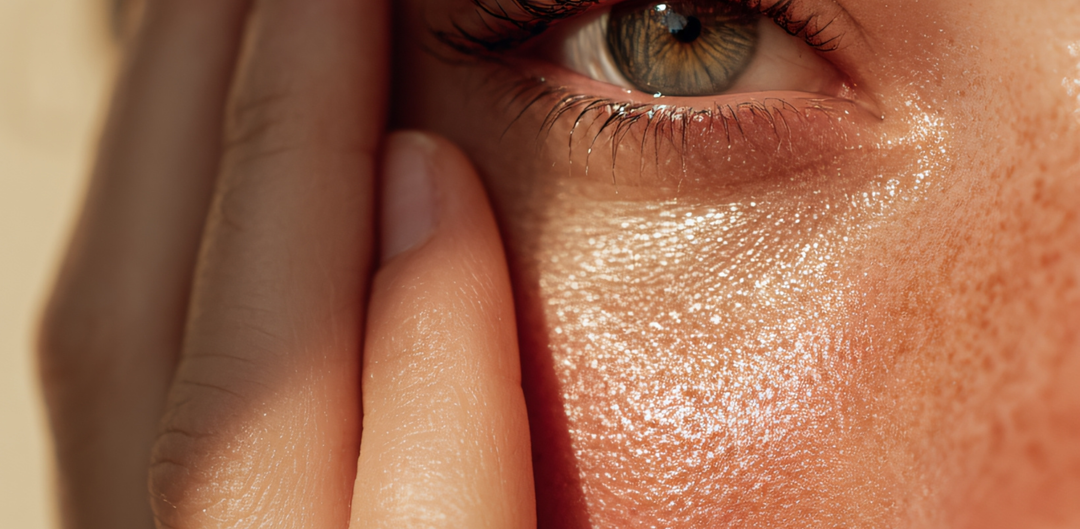Non-comedogenic skincare refers to products formulated to avoid clogging pores. In this blog, we explore what it means, how to identify non-comedogenic ingredients, and how to build a routine that supports clear, balanced skin.
What Does Non-Comedogenic Mean?
Non-comedogenic means a product is formulated not to clog pores (aka comedones). Pores can become blocked by certain ingredients, causing blackheads, whiteheads, and breakouts.
When a product is non-comedogenic, it’s typically free from heavy oils or waxes that are more likely to sit on the skin’s surface and trap debris.
How Is Comedogenicity Measured?
Comedogenicity is measured using a comedogenicity scale, which ranks ingredients from 0 to 5:
-
0 – Will not clog pores
-
1 – Very low likelihood
-
2 – Moderately low
-
3 – Moderate
-
4 – Fairly high
-
5 – High likelihood of clogging pores
⚠️ Keep in mind: Formulas matter more than single ingredients. An ingredient rated 3–4 on its own might not be problematic in a well-balanced formula.
Why Does Non-Comedogenic Matter for Acne-Prone Skin?
If you’re dealing with breakouts or congestion, using non-comedogenic skincare helps ensure that your routine supports healing and won't exacerbate existing issues.
Here’s why it matters:
-
Minimises clogged pores: Acne often begins when a pore is blocked.
-
Reduces inflammation triggers: Many pore-clogging ingredients are also irritating.
-
Balances oil levels: Non-comedogenic oils can nourish skin without disrupting sebum production.
When you're prone to acne, every product you apply can either support your skin or sabotage it. Non-comedogenic products help keep things on the supportive side.
Customer Review: SkinTonic
"The Best Oil Ever: I have tried all sorts of oils on my face but have always found them very heavy, clogging up my pores. I waited to write this review to be sure that the product was really benefiting my skin, and hand on heart, this oil is amazing! It's light and my skin immediately responded by feeling calmed and soft. I've had really blemished skin all my life and this oil is actually decongesting my pores. My skin has never looked better and I look forward to my daily cleansing ritual. I can't recommend this oil more highly!" - Verified 5 Star Hark & Zander Review, Lana Coles
How Can You Tell if a Product Is Non-Comedogenic?
There’s no legal standard for this term, but here’s how to decode it:
-
Check for claims on the label: “non-comedogenic,” “won’t clog pores,” or “oil-free.”
-
Look at the texture: Heavy creams and balms are more likely to clog pores (although, this is definitely not definitive!).
-
Review the ingredient list: Get familiar with comedogenicity ratings (we'll list common offenders next).
💡 Tip: Sites like CosDNA or INCIDecoder let you plug in an ingredient list and check comedogenicity ratings quickly.
Which Ingredients Should You Look For and Avoid?
Ingredients to Avoid If You're Acne-Prone:
These tend to have high comedogenic ratings:
-
Coconut oil
-
Isopropyl myristate
-
Lanolin
-
Wheat germ oil
-
High concentrations of cocoa butter
These ingredients can be great in some contexts but may trap bacteria and dead skin in acne-prone individuals.
Ingredients That Are Non-Comedogenic (and Beneficial):
-
Kōakaheart oil: Balances oil, calms inflammation, and won’t clog pores.
-
Jojoba oil: Mimics skin’s natural sebum and supports barrier health.
-
Rosehip oil: Light, antioxidant-rich, and helps fade post-acne marks.
-
Niacinamide: Regulates oil and soothes inflamed skin.
-
Hyaluronic acid: Deeply hydrating and lightweight.
How Do You Build a Non-Comedogenic Skincare Routine?
Layering non-comedogenic products in the right order maximises benefits while reducing risk of breakouts.
Here’s the ideal order:
-
Cleanser – Start with a gentle, non-stripping cleanser to clear dirt and facial oil.
-
Toner – Use a balancing toner that preps skin without alcohol or irritants.
-
Serum – Target skin concerns like dehydration, oiliness, or congestion.
-
Day Crème or Night Crème – Choose lightweight hydration that nourishes without clogging.
-
Face Oil – Always apply oil last to seal in hydration.
✨ Our full ritual includes:
-
SkinTonic Face Oil - with Kōakaheart
These are all non-comedogenic, natural-based, and clinically backed for skin that needs balance.
Tips for Choosing Non-Comedogenic Skincare Products
-
✅ Read full ingredient lists — not just front labels
-
✅ Patch test new products before full use
-
✅ Use lighter textures if your skin feels congested
-
✅ Stay consistent — switching too often can cause flare-ups
-
✅ Listen to your skin — even “safe” ingredients can irritate some
Can Natural Skincare Be Non-Comedogenic?
Yes, absolutely!
Natural oils and botanical extracts can be extremely beneficial, especially when chosen mindfully. Some of the best non-comedogenic oils come straight from nature.
Examples include:
-
Kōakaheart oil (our signature botanical oil)
-
Jojoba oil
-
Squalane
-
Calendula extract
Our approach blends nature and science, ensuring every formula feels luxurious and supports skin clarity.
What If You Still Break Out?
Sometimes, breakouts happen even with non-comedogenic skincare. Here's what to consider:
-
Is your skin purging? A temporary adjustment can happen when introducing actives.
-
Could it be another product? Makeup, sunscreen, or hair products may be the culprit.
-
Are you layering correctly? Oils before creams can trap moisture and bacteria.
-
Do lifestyle factors play a role? Stress, hormones, sleep, and diet all influence breakouts.
Skincare is one piece of the puzzle but when you get it right, it supports everything else.
FAQ
Q: Can natural oils be non-comedogenic?
A: Yes! Kōakaheart, jojoba, and rosehip oils are all non-comedogenic and beneficial for acne-prone skin.
Q: What’s the difference between non-comedogenic and oil-free?
A: Oil-free means no oils (synthetic or natural) are used. Non-comedogenic means oils can be used, but only those unlikely to clog pores.
Q: Is “non-comedogenic” a regulated term?
A: No — which is why reading ingredients is so important. Brands can label products non-comedogenic even if they include comedogenic ingredients.
Q: Can dry skin be acne-prone too?
A: Yes — acne isn’t always about excess oil. Even dry skin can develop congestion if the wrong ingredients are used.
Q: What if I’m not sure which ingredients clog my pores?
A: Keep a journal or use an ingredient checker app to spot patterns and avoid your personal triggers.
Wrap-Up: Build Your Routine With Balance in Mind
Choosing non-comedogenic skincare doesn’t have to be complicated. Look for gentle, plant-based ingredients that let your skin breathe, stay consistent, and give your skin time to adjust.
✨ Explore our non-comedogenic range crafted with Kōakaheart and other pore-friendly botanicals. Your skin will thank you!





